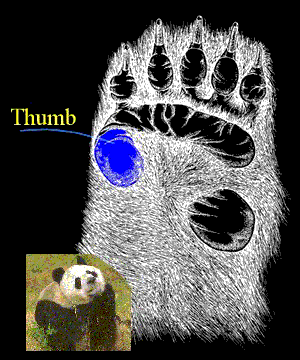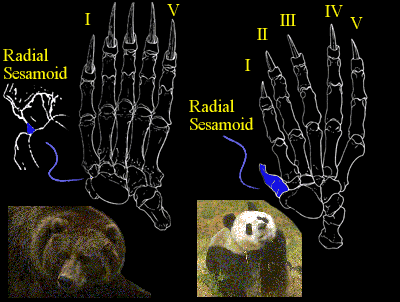Hello, fellow science lovers! I'm back with another edition in my series. This article is about a very curious appendage on our friend the giant panda. The panda's "thumb" provides easy-to-understand, visually compelling evidence for evolution. Let's take a look.
First, let's review a few basic facts about pandas. What is their pedegree? Who are they related to? The San Diego Zoo says:
For years scientists have wondered whether pandas are bears, raccoons, or in a group all their own. Through studying the genetic code (DNA) in pandas? cells, scientists have confirmed the panda's relationship with bears. Giant pandas are similar to other bears in their general looks, the way they walk and climb, and their skull characteristics.
( http://www.sandiegozoo.org/animalbytes/t-giant_panda.html )
So the panda is truly a bear. But unlike other bears, the panda is peculiar in that it does not eat meat, but subsists almost entirely on bamboo. The San Diego Zoo has this to say about the panda's diet:
They spend at least 12 hours each day eating bamboo. Because bamboo is so low in nutrients, pandas eat as much as 84 pounds (38 kilograms) of it each day. Pandas grasp bamboo stalks with their five fingers and a special wristbone, then use their teeth to peel off the tough outer layers to reveal the soft inner tissue.
Notice the "special wristbone" mentioned in the quote above. Here's an illustration of this special appendage on the panda:
(All pictures from http://www.athro.com/evo/pthumb.html)
We can call this a thumb, because it is opposable to the main pad and allows the panda to hold and manipulate bamboo shoots. However, there is a very curious fact about this thumb. Take a look at the following picture, showing the underlying skeletal structure:
As you can see, the panda has five normal appendages in addition to the thumb appendage. Notice that the normal appendages are comprised of multiple bones (as in our own fingers), while the thumb is a single bone.
It turns out that the bone structure in a panda's paw is very similar to that in other bears. The thumb appendage is exactly where other bears have a small bone called a radial sesamoid. Take a look at the following illustration:
We can see clearly that where the grizzly has a radial sesamoid, the panda has a thumb. It is shifted in position and is pointing a different direction, but it is clearly the same bone. The purpose of the radial sesamoid in other bears is to strengthen a tendon in that area. In the case of the panda, however, this bone has been co-opted to help it eat bamboo shoots. Because there was selective pressure favoring large radial sesamoids (that is, pandas with large radial sesamoids were able to eat more easily and therefore survive better, thus passing on their large-sesamoid-genes), the panda gradually has evolved a thumb-like appendage from what was originally nothing more than a minor wristbone.
This is a very good example of evolution in action because it showcases several key aspects of evolution:
- The design is not "good" by any definition of the word. It is a jury-rigged system that used what was available to the advantage of the panda.
- By co-opting existing features and slowly adapting them to another purpose, evolutionary forces have introduced a new biological feature (a new appendage).
Evolution always takes existing material and co-opts to new uses. Sometimes this results in the introduction of a new biological feature. This is what happened with the panda. Given enough time and selective pressure, the thumb would continue to be honed to the task of eating bamboo until an observer might marvel at how well-designed it was. In reality, though, it was just a random bone that happened to be in the right place at the right time for a group of pandas long ago. It helped those pandas survive. The pandas with the bones shaped better for the particular task of eating bamboo were selected for survival among their peers, so they had baby pandas with similar bones, and so on and so forth.
And thus was born the panda's thumb. So that's it for this installment - I hope you've enjoyed it! Now get out there and tell all your friends about the panda's jury-rigged thumb! :-)
SNG
Appendix: Previous articles:
Retroviral sequences: http://www.jehovahs-witness.com/6/86797/1.ashx
Cytochrome c: http://www.jehovahs-witness.com/6/87238/1.ashx
What evolution is not: The role of randomness: http://www.jehovahs-witness.com/6/87711/1.ashx
Mitochondrial DNA, part 1: http://www.jehovahs-witness.com/6/87781/1.ashx
Mitochondrias DNA, part 2: Neandertals: http://www.jehovahs-witness.com/6/88271/1.ashx
Atavisms and Vitamin C: http://www.jehovahs-witness.com/6/88649/1.ashx
Isolated Species: http://www.jehovahs-witness.com/6/89867/1.ashx
The Bible Requires It: http://www.jehovahs-witness.com/6/90287/1.ashx


